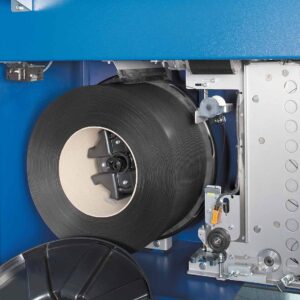When it comes to packaging efficiency and load security, few tools are as essential as the PP strapping machine (also known as a polypropylene strapping machine or box strapping machine). Whether you’re running a high-volume production line or packaging a small number of cartons each day, the right machine can save time, reduce costs, and improve safety.
This guide explains what a PP strapping machine is, how it works, the different types available, their advantages, how to select the right one, compliance requirements, and common applications.
1. What Is a PP Strapping Machine?
A PP strapping machine is designed to apply polypropylene (PP) straps around packages, cartons, or pallets to keep them secure during storage and transportation.
PP straps are a popular choice because they are:
- Lightweight yet strong – Ideal for cartons and light pallets.
- Cost-effective – Affordable compared to PET or steel straps.
- Moisture and chemical resistant – Suitable for a wide range of environments.
- Elastic and flexible – Can absorb shocks during transit without breaking.
🔗 Check out our products: PP Strapping Band
2. How Does It Work?
The basic working process of a PP strapping machine involves:
- Strap Placement – The strap is wrapped around the package (automatically or manually).
- Tensioning – The machine pulls the strap tight to a preset tension.
- Sealing – The strap ends are sealed together by heat, friction welding, or using a buckle.
- Cutting – Excess strap is trimmed for a neat finish.
This automated process ensures speed, consistency, and reduced manual labor.
3. Types of PP Strapping Machines
PP strapping machines come in different types to suit various packaging volumes, product sizes, and budgets:
- Fully Automatic Strapping Machie: Integrated into a conveyor or production line; automatically feeds, tensions, seals, and cuts the strap.For high-volume manufacturing, logistics centers.
- Semi-Automatic Strapping Machie: Operator manually feeds the strap; machine then tensions, seals, and cuts. For small to medium businesses, mixed product sizes.
- Electric (Battery-Powered) Strapping Machine: Portable handheld tool powered by rechargeable batteries; uses friction welding for sealing. For warehouses, mobile packaging needs.
- Pneumatic Strapping Machine: Uses compressed air for high-tension strapping; ideal for heavy-duty loads. For Industrial packaging, steel/timber industries.
- Manual Strapping Machine: Hand-operated using a tensioner, sealer, and buckles; no power required. For Low-volume work, backup use.
🔗 Check out our products: PP Strapping Machines
4. Advantages of PP Strapping Machines
- Faster Packaging – Saves time compared to manual strapping.
- Consistent Quality – Uniform tension and sealing.
- Labor Savings – Fewer operators required.
- Improved Safety – Reduces strain and injury risk.
- Professional Finish – Neater packaging improves presentation.
5. How to Choose the Right PP Strapping Machine
Before purchasing, evaluate:
- Daily Packaging Volume – High volumes = automatic; low volumes = semi-auto/manual.
- Product Size & Weight – Ensure machine can handle your largest items.
- Strap Size Compatibility – Match with your strap width & thickness.
- Power Source – Electric, pneumatic, or manual depending on setup.
- Work Environment – Durable machines for dusty, humid, or outdoor sites.
- After-Sales Support – Check warranty, spare parts availability, and local service.
💡 Tip: A quick ROI calculation (labor cost savings vs. machine cost) often shows payback within months for semi- and fully automatic models.
6. Certifications and Compliance
When purchasing a PP strapping machine, it’s crucial to verify compliance with international safety and quality standards:
- CE Certification (mandatory in Europe): Confirms that the machine meets EU safety, health, and environmental requirements. Machines without CE marking cannot be legally sold or installed in the EU. → Learn more about CE certification.
- ISO 9001 Quality Standards: Many reliable manufacturers follow ISO-certified processes to guarantee consistent quality.→ Learn more about ISO Standards.
- Local Regulations: In some regions, additional certifications such as UL, CSA, or RoHS may apply.
Always request CE certificates and compliance documents from your supplier before committing to a purchase.
7. Common Applications of PP Strapping Machines
- E-commerce & Warehousing – Securing parcels for delivery.
- Manufacturing – Bundling finished goods for shipping.
- Food & Beverage – Strapping cartons for safe distribution.
- Logistics & Freight – Stabilizing pallets during transport.
- Printing & Publishing – Bundling stacks of paper or magazines.
8. Maintenance & Safety Tips
- Clean dust/debris from machine regularly.
- Lubricate moving parts according to manufacturer instructions.
- Replace worn sealing components (heating elements, welding pads).
- Train operators to avoid strap misfeeds and improper tension settings.
- Keep spare parts in stock to minimize downtime.
9. FAQs
Q: Can I use PET straps in a PP strapping machine?
A: Not usually—machines are designed for specific strap materials. Use only compatible straps.
Q: How long does a strapping machine last?
A: With proper maintenance, 5–10 years is typical for industrial models.
Q: What’s the price range?
- Manual tools: $30–200
- Semi-automatic machines: $300–1500
- Fully automatic systems: $1300+
Buying the right PP strapping machine requires balancing your packaging needs, budget, and production volume. By carefully evaluating machine type, capacity, strap compatibility, after-sales service, and CE certification, you can invest in equipment that delivers long-term value—keeping your packaging fast, safe, and professional.
👉 Contact us now!— our team will provide tailored advice, a quote, and arrange a machine demonstration to match your packaging needs.

